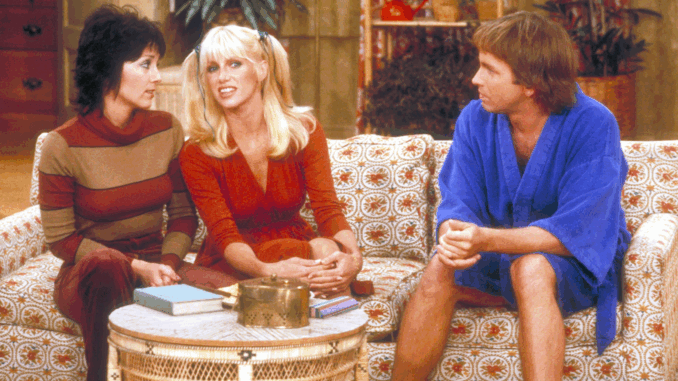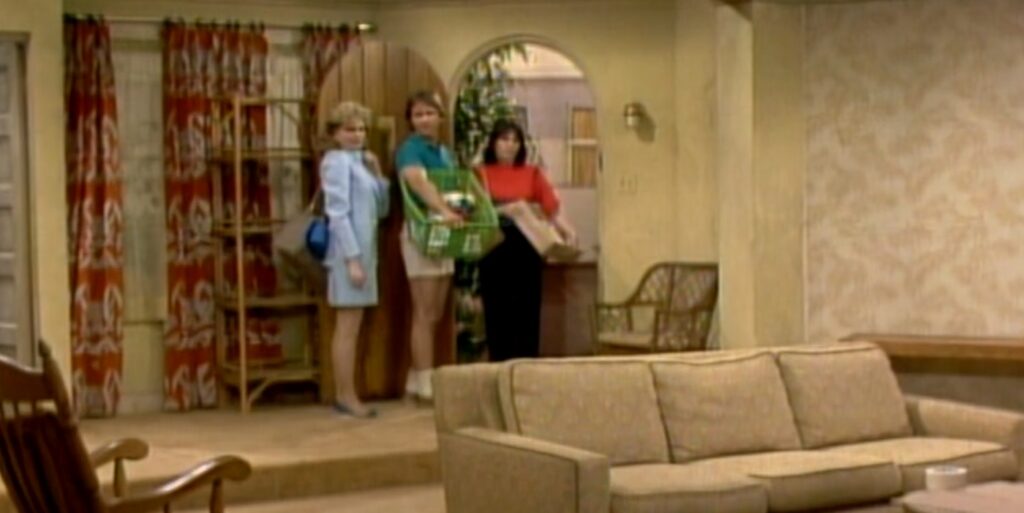
Long before modern sitcoms mastered the art of awkward living arrangements and quirky friendships, Three’s Company set the gold standard. On paper, it was simple: a guy moves in with two girls. In practice, it was explosive, hilarious, and decades ahead of its time. Today, more than 40 years after its debut, Three’s Company isn’t just a nostalgic laugh track—it’s a masterclass in comic chaos, accidental activism, and how a single apartment became the most controversial address on television.
A Time Bomb in Bell-Bottoms
When Three’s Company premiered in 1977, America wasn’t quite ready for it—and that’s exactly why it worked. Jack Tripper (played by the late, legendary John Ritter) agrees to share an apartment with Janet and Chrissy, two single women. The only catch? To satisfy their judgmental landlord, Jack pretends to be gay.
That one storyline, meant for laughs, became a seismic shift in network television. Suddenly, TV was talking (albeit jokingly) about sexuality, gender roles, and cohabitation. What seemed like innocent farce was actually poking holes in cultural norms—and viewers couldn’t get enough.
Jack Tripper: The Comic Acrobat Who Carried the Show
John Ritter didn’t just play Jack Tripper—he turned him into one of the most agile, lovable goofballs in sitcom history. His timing was sharp, his physical comedy was gymnastic, and his charisma practically burst through the screen. Ritter made pratfalls look like ballet. Every tumble, every double take, every wrong-door entrance was finely tuned comedic art.
Behind the laughs, Ritter gave Jack something rare: vulnerability. He wasn’t the macho alpha or the clueless idiot—he was kind, confused, and constantly caught in the web of his own white lies. That’s why audiences rooted for him, episode after episode.
Not Just Pretty Faces: The Women Who Balanced the Madness
While Ritter shined, it was his co-stars who kept the show grounded. Joyce DeWitt’s Janet was smart, steady, and subtly feminist—a rarity in 1970s television. Suzanne Somers’ Chrissy, often labeled the “dumb blonde,” was actually a clever inversion of the trope. She was naïve, yes, but sweet, fearless, and far from helpless.
Their chemistry made the show sing. It wasn’t romantic tension that powered the trio—it was friendship. They squabbled, supported each other, and formed one of the most unique platonic dynamics TV had ever seen.

More Than Laughs: A Show That Broke the Rules
Three’s Company didn’t just hint at taboo subjects—it danced through them with wide-eyed innocence. It made jokes about sexuality, challenged living norms, and played with stereotypes—but it also invited audiences to rethink them. Even the landlords, Mr. and Mrs. Roper (and later Mr. Furley), became satirical reflections of outdated attitudes.
The show constantly walked a tightrope between controversy and comedy. And even when it stumbled—like during Suzanne Somers’ high-profile departure or uneven later seasons—it never lost its rebellious energy.
The Blueprint for Sitcoms That Followed
Watch any modern ensemble sitcom—Friends, New Girl, The Big Bang Theory—and you’ll see echoes of Three’s Company: mismatched roommates, sexual tension, a recurring neighborhood hangout, and the ever-revolving door of comic misunderstandings. But none had quite the same chaotic, taboo-defying spirit.
Three’s Company made sitcoms less polite and more human. It gave us characters who lied, blushed, fell down, got dumped, and still found ways to laugh. It didn’t teach lessons—it showed life’s absurdities and invited us to laugh along.
Why It Still Matters
Even in an age of complex, serialized storytelling, Three’s Company still holds its charm. It wasn’t trying to be deep—it just was. The show let absurdity breathe. It was sexy without being explicit, outrageous without being mean, and clever without losing its goofball heart.
Reruns still air, fan pages still thrive, and nostalgia-driven reunions still spark excitement. The apartment at 201 (and the Regal Beagle just down the street) lives on—not just as a setting, but as a symbol of a time when TV took a leap into the ridiculous…and landed on both feet.
In the end, Three’s Company wasn’t just ahead of its time. It cracked the sitcom formula wide open and dared the world to laugh while questioning the rules. And for that, the door is always open.
